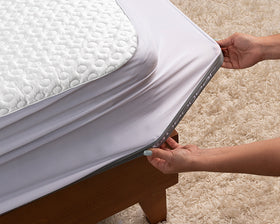888-996-9890

Choosing the Right Mattress
Most of us don’t put enough thought into choosing the right mattress and getting a good night’s sleep is essential for your short and long-term health. Choosing the right mattress ensures that you get the great night’s sleep you deserve. When choosing a mattress, keep in mind your sleeping style, position and the specific needs of your body. The way you sleep should greatly influence which mattress is right for you.
Back Sleepers. Sleeping on a mattress that does not have enough support causes muscle strain in the back and increases the chance you will assume a poor posture during sleep. The lower back must have adequate support without being too stiff. The best mattresses for back sleepers normally fall towards the “firm” end of mattresses, where the mattress is able to give that support without being too stiff. Back sleepers tend to prefer a medium to firm firmness in a mattress. A firm mattress provides stability throughout the night and helps the bones and muscles relax while they get the support they need. Back sleepers benefit more from a firm mattress because a firmer mattress allows the body to be more evenly distributed across the bed.
Recommendations:
Medium Firm, Extra Firm and Ultra Firm Mattresses. A mattress designed with a firm coil system with compressed, firm upholstery layers, will provide a firm, but not hard comfort level for back sleepers. Individually wrapped coils with firmer and conforming foams will create a sleeping surface that will allow the body to “float” as you sleep. Extra Firm is a good choice for back sleepers. Pay attention to the coil count of a mattress, the higher the count, the more firm the mattress. The right mattress will offer a combination of flexible, yet firm fibers to cradle the most important parts of your body.
Side Sleepers. The best mattress for side sleepers will be sensitive to pressure points, preserve natural alignment, and accommodate to the natural curves of your body. A bed that is slightly softer and designed to relieve pressure points will provide adequate support for these types of sleepers. Ideally, the best mattress will provide the perfect combination of support and structure with softness and cushion. An extra layer of padding will contour the natural curve of the body and help hips and shoulders remain aligned. Sleeping on either of your sides actually increases pressure on shoulders, neck, and hips.
Recommendations:
Firm Plush. A firm plush mattress is ideal for side sleepers since it offers some quilted padding under the surface of the mattress which provides pressure relief for the shoulders, arms, and hips. A plush mattress is the best way to maintain the natural shape of the spine while sleeping. It will cradle the body and prevent the spine and belly form sagging down.
Latex Mattress. A Latex foam mattress will conform to your unique body shape and weight, absorb the movement of a fidgety partner, and since they are soft and resilient, these mattresses spread your body weight evenly to promote restful sleep.
Memory Foam. Memory foam molds to the shape and contours of your body, naturally aligns your neck and spine by providing adequate support to pressure points, and it gets softer when it comes into contact with body heat. Memory foam mattresses are made using visco-elastic polyurethane foam, and it is ideal for side sleepers and those who have problematic pressure points.
Stomach Sleepers. The best mattress for stomach sleepers is one that holds your body in a neutral position. The mattress should be soft, yet, firm enough to create a slight lift under the hips so the gentle curve of the spine remains intact, yet “anchor” the body in place while decompressing joints and muscles. Durability is a factor for many stomach sleepers who may suffer from lower back or neck pain, and traditional innerspring mattresses make them more susceptible to the pressure points provided by the springs.
Recommendations:
Memory Foam Mattress. A Memory Foam mattress designed to conform to the shape of your body will relieve pressure points and help in the reduction of body aches. With its medium to soft feel, it is ideal for those who want comfort and support while they sleep on their stomachs because it has the ability to compress and yet come back to its original shape faster.
Latex Mattress. Latex beds offer the perfect balance of firmness and contouring to relax the neck and whole body evenly. Latex foam contours to the body’s curvature, and offers just the right combination of comfort and support. It is resilient and changes shape as you change sleeping positions. These beds are ideal for arthritis sufferers, as well as those who have fibromyalgia and other pain related conditions.
Medium-Firm Mattress. Ideal for stomach sleepers, a medium firm mattress will provide supportive density, but also have enough give to conform to the bumps and curves of the body. Helpful in managing chronic low back pain, a medium firm mattress provides good support while distributing pressure points on the body when lying in bed.
Trust your body’s comfort zones and preferences…. There is no one mattress for everyone.





